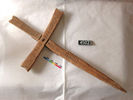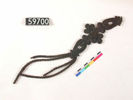| Homepage | Timeline | Maps | A-Z index | Learning |
Burial customs of the Roman Period in Egypt: the impact of Christianity
It is impossible to give a precise date for the end of pagan burials customs. There are some pagan/ancient Egyptian traditions which continued into the Christian era, such as mummification and the custom of depositing objects in burials. The body of the dead were normally placed in shallow holes. They were buried in their daily life dress, perhaps in especially fine garment; as a result vast quantities of 'Coptic textiles' have survived, making Egypt a primary source for our knowledge of the clothes worn in the Eastern Roman Empire. Jewellery also seems to be common in burials of the period, and can be regarded as part of the daily life dress. In some tombs of women simple terracotta figures have been found. They seem to relate to female fertility, a survival of pre-Christian traditions, still alive even into the Islamic Period.
Elite tombs were marked on the surface with a tomb stone. At Lahun were found remains of inscribed crosses. It is not known whether the burials of poorer people were marked on the surface.





